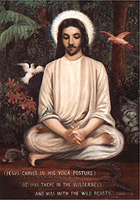Cambridge, MA. On this first Sunday of Lent, February 26, we heard a remarkably brief version of Jesus’ time in the desert: “And the Spirit immediately drove him out into the wilderness. He was in the wilderness for forty days, tempted by Satan; and he was with the wild beasts; and the angels waited on him.” (Mark 1:12-13) No mention of fasting; no detailing of three temptations by Satan. Just the desert, the beasts, Satan, angels. Yet it is a valuable Gospel for us to hear right now, when it is still early enough in Lent for us to reimagine how we shall live the next few weeks. 
Think about it: After and not before his Baptism, the descent of the Spirit upon him, and the heavenly voice, but before he begins to preach, Jesus goes to the desert. It is as if he must be alone, to understand the gift he has already received. Or rather, he does not go of his own free will, but “driven by the Spirit.” My thought, when I preached this morning, is that we might try this approach this Lent: wait upon the Spirit, and see where the Spirit drives us, in terms of aloneness, prayer, penance, desert and abundance. If nothing happens, if we do not feel the push of the Spirit, then just waiting for God may be the best Lent of all.
Mark does not mention fasting, nor does he play up the rigors of the desert, the heat and cold, the dryness, etc. All he says is that Jesus was “with the wild beasts.” While this might be an oblique reference to Psalm 91, the simple words do us well: to be where the wild beasts are, outside civilization, beyond the bounds of what we ordinarily do and ordinarily expect. With the beasts – metaphorically, perhaps, the wilder parts of ourselves, parts we might ordinarily be afraid of: our desires or lusts, our angers or fears, our depressions or unruly dreams. Be with our inner beasts – not against them, nor hunting them, nor clinging to them, nor fleeing from them – during the weeks of Lent. That may well be a good enough Lent, this year.
Mark makes no mention of three temptations, and we can leave that famous trio aside. All we hear is that Jesus was “tempted by Satan” and “waited upon by angels.” It is as if Jesus, alone in that desert to which the Spirit drove him, patiently with his wild beasts, is tempted and consoled, dragged toward the dark and invited back into the light, back and forth, opposing forces drawing him this way and that, as he watched, observing all that happened. This is, of course, something familiar from the Spiritual Exercises of St. Ignatius: observe your desolations and consolations; notice where Satan implicates himself in your life; and rejoice in the small and subtle gifts of ministering angels. In all of this, God will speak to you.
In the end, Jesus gets up and returns to the city. As Mark puts it: “Jesus came to Galilee, proclaiming the good news of God, 15and saying, ‘The time is fulfilled, and the kingdom of God has come near; repent, and believe in the good news.’” (Mark 1.14b-15) Now, after this time among the beasts, whether he fasted or not, Jesus leaves behind his demons and angels, and tells the world the time has come for a change of heart, new faith: the Kingdom has already come.
I cannot help but add an interreligious note. The picture accompanying this blog is of “Jesus Christ in His Yoga Posture,” a painting from the 1920s by the American Catholic artist Eugene Theodosia Oliver. He painted it for the Ramakrishna Vedanta Society. The original is in San Francisco, but the picture is familiar and found in many places around the world. The story behind it is nicely summarized by Boston University professor Stephen Prothero at Beliefnet, along with his own interpretation of its meaning.
This Jeus practicing yoga is as it were a Hindu Jesus, Jesus the yogi, but the words on the painting are from today’s Gospel: “He was there in the wilderness and was with the wild beasts.” While there are all kinds of things that might be said about yoga, Jesus and yoga, and who gets to imagine what Jesus would do were he beginning his ministry today, there is something simple and right about Oliver’s painting, particularly in light of Mark: driven by the Spirit, with the beasts, between Satan and the angels, Jesus sees that the Kingdom has come near.
Cannot we do the same this Lent? We can imagine ourselves like this Jesus: waiting to be driven by the Spirit – alone in our desert – peaceably with our wild beasts – noticing how Satan tempts us, letting angels minister to us: and then at Easter, we may find ourselves not only recipients of the Good News, but also its preachers.







http://www.nytimes.com/2012/03/03/arts/in-the-company-of-animals-opens-at-the-morgan-library.html?_r=1&hp